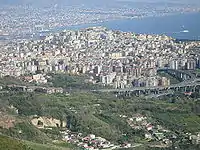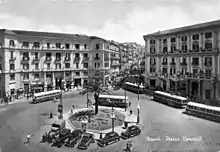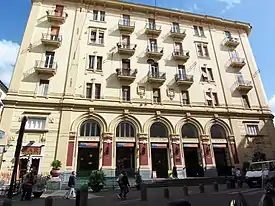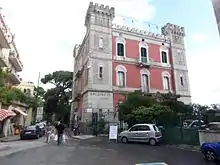Vomero
Vomero (pronounced [ˈvɔːmero]) is a hilltop district of downtown Naples, Italy, with an area of approximately two square kilometers and a population of 48,000.
Vomero | |
|---|---|
District of Naples | |
| District | |
With its prominent hilltop location, Vomero is noted for the medieval fortress, Castel Sant'Elmo; its three funiculars connecting to adjacent historic districts — and its vantage, overlooking greater Naples, Mount Vesuvius, the Bay of Naples and the Tyrrhenian Sea.
The quarter borders Arenella, Soccavo, Fuorigrotta, Chiaia, Montecalvario and Avvocata. Streets are named after noted Neopolitan painters, sculptors, composers and architects — prominent at the time of the quarter's initial development.
Once primarily agricultural, Vomero is now heavily urbanized. Residents go by the demonym Vomeresi. The highest point of the neighborhood is the Certosa di San Martino with an altitude of 251 metres.
Questa contrada detta il Vomere è ricca di monasteri e di bellissime casine per essere l'aria salutifera avendo un aspetto al mare (This district called the Vomere is rich in monasteries and beautiful little houses to be the healthy air having an aspect to the sea)



Nike named a pair of shoes with the neighborhood's name, the Nike Vomero
Etymology
During the very earliest period, when Greek settlements were established in the Naples area in the second millennium BC, the Vomerese hill was called Bomòs (βωμός, or "high ground"). By the sixteenth century the name Vomero was used, possibly a corruption of the Greek Bomòs.
In Roman times, the hilltop area was called Paturcium, from Patulcius, a name related to Giano, the god to whom the hill was dedicated. In the early Middle Ages, via linguistic corruption, this became Patruscolo or Patruscio.
The name Vomero took hold at the end of the sixteenth century, deriving from the area's agricultural history — and initially referring to a historic farmhouse located on the hill, rather than the hill itself.
The word vomere, refers to a ploughshare (the blade of a plough); and also a contemporaneous agricultural game that would award the plowman who could trace the straightest furrow.
The hilltop's agricultural activity earned it various nicknames, including Broccoli Hill, il Quartiere dei Broccoli and Collina dei Broccoli.
History

Until the end of the nineteenth century, Vomero constituted an almost uninhabited periphery, far from the city of Naples. Its most ancient parts, e.g., the Antignano district, were rural dwellings and villages remaining from Roman times, near the "Via Puteolis Neapolim per colles" road — that before the excavation of the tunnel connecting Fuorigrotta and Mergellina was the only land connection between the Phlegraean area and the city. Around the 2nd century AD the street was rearranged and called via Antiniana, hence the name of the district. Precisely in the ancient village that today is the district of Antignano, tradition has it that the miracle of San Gennaro took place for the first time, between 413 and 431. Geographically, Vomero is noted for its hilltop location, originally connected to the Naples downtown by a series of Petraio, ancient alluvial deposits descending the hillside, ultimately becoming a series of stairs and ramps which remain today.
Later, after the Norman and Swabian domination, with the Angevins Naples became the capital in 1266 (it remained so until the Unification of Italy in 1860). Thus the need to rise up the slopes of the Vomerese hill began to arise, above all for strategic reasons. Thus the area began to populate especially since the construction of the Carthusian Cloister in 1325 and almost simultaneously the Angevins replaced the ancient watchtower (of the Norman period) near which the Cloister was built, with the Castle of Belforte, the starting point of the Castel Sant'Elmo. However, the structure of the remaining vomerese territory remained unchanged. OttoUnder the Aragonese and then under the Spaniards, Naples experienced a dizzying demographic increase, due to the strong immigration from the Iberian peninsula and the rest of the kingdom. The need to widen the city territory led the Viceroy Pedro Álvarez de Toledo to direct the development of the city (then only flat) towards the slopes of the hills, which until then had been devoid of significant residential settlements. However, in 1556 a law forbade the construction of new buildings around Sant'Elmo and, in 1583, even on the slopes of the hill.
_-_View_of_Forte_Sant'Elmo.jpg.webp)
In the period of the viceroys following Don Pedro, the building expansion followed, causing the merger of innumerable villages; even on the hill more homogeneous agglomerations began to form, villages and hamlets. In the seventeenth century in the cartography of the city the first hilly constructions began to be represented.[2]
During the plague of 1656, the hill was used as a refuge by the nobility and clergy: in fact the tendency in the aristocracy residing in the historic center to establish a second home at the Vomero, a tendency that will be accentuated during the eighteenth century, was affirmed especially thanks to the opening of the new "Infrascata street" (Via Salvator Rosa). Among the many noble families who settled in Vomero, the Carafa, the Counts of Acerra, the Ruffo di Sicilia, the Cacciottoli, the Cangiani.
In 1817, the Vomero was promoted to the rank of residence not only noble, but also royal, with the acquisition of a villa by Ferdinand I of Bourbon: the future Floridiana.
In 1809, in the new administrative division of the city operated by Joachim Murat, all the villages of the Vomero became part of the city proper, in the district of the Avvocata. Finally, towards the middle of the 19th century, the opening of Corso Maria Teresa (renamed Corso Vittorio Emanuele after 1860), commissioned by Ferdinando II, delimited the lower border of the future Vomero district.
The foundation of the new Rione and the urbanization of the Vomero

The actual housing development of Vomero began towards the end of the nineteenth century, more precisely in 1885, with the foundation (under the law "for the Restoration of Naples") of the New District and the design of a road layout to reticular mesh and radial pattern that applied the rationalistic dictates in vogue throughout the European urbanism of the end of the century, according to the example of Baron Haussmann's Paris (similar experiences in Italian urbanism are found in the Roman quarters of Esquilino and Testaccio). from the first moment the Vomero was conceived as a residential neighborhood destined for the upper-middle classes: the splendid villas and buildings in late Liberty style that were built in large numbers at the beginning of the century around the Villa Floridiana and towards the area of Castel Sant'Elmo and San Martino's constituted the distinctive feature of the new district until the mid-20th century.

In addition, before the law on recovery, a Piedmontese bank, the Tiberina bank, had purchased land at the Vomero between San Martino, via Belvedere and Antignano, with the intention of building a new neighborhood (Garibaldi had already thought of this to the hilly areas as potential new wards, where, however, he believed the proletariat should be hosted) The laying of the foundation stone by the sovereigns took place on 11 May 1885 and, on 20 October 1889, the New Rione was inaugurated, with the opening of the Funicular of Chiaia, followed by the Funicolare di Montesanto in 1891.
Until that date, but still for several decades later, life and therefore the history of the Vomerese hill and that of the city of Naples evolved separately. "I go to Naples", "I go down to Naples" were the sentences of the vomeresi to indicate the journey to the center of the city. But, after 11 May 1885, the Vomero slowly began to settle territorially with the city.
The first example of "urban" buildings was the "Four Palaces" in Piazza Vanvitelli, built at the beginning of the 20th century by Banca Tiberina. After the beginning of the works, however, the scarce reactivity of the market (due to the economic difficulties of the time and the still difficult connections between the city and the hill) pushed the bank (owner of the built-up areas and of the two funiculars) to yield in the 1899 its rights to the Bank of Italy. This caused the suspension for several years of the works envisaged by the urbanization plan (the result of the agreement signed between the Municipality and Banca Tiberina). At the beginning of the twentieth century, only a part of the buildings in the center of the Vomero (between Piazza Vanvitelli, along Via Scarlatti and Via Morghen) were made (in addition to the layout of the subdivision). All the new buildings were in neo-Renaissance style, which in Naples will last until the first three decades of the twentieth century, dragging the projects of the late nineteenth century through the years.
The Bank of Italy, in order to recover the capital invested, decided to sell the buildings already built and the land, and split the blocks into smaller lots that could be more easily sold. Consequently, in the early years of the twentieth century there was no impetuous urban development, but less intensive construction of small, two-storey and small-scale villas was built, surrounded by pretty gardens; which, moreover, had the ability to better enhance the landscape aspects of the places, compared to the large Umbertine buildings. The architectural taste that characterized the period, up until the mid-twenties, was that defined liberty together with the so-called neo-eclectic.
The construction of small lots, which began at the beginning of the century, continued even after the first world war and continued to attract a new social class, able to acquire single-family homes or for a few families, formed mainly by professionals, entrepreneurs, people anyway wealthy who, with their needs and their way of life, defined the character of the new neighborhood, where in this period life began to take its habits, revolving around Piazza Vanvitelli, the funiculars, the axes of via Scarlatti and via Luca Giordano. [...] The development of the areas of via Aniello Falcone, via Palizzi, the "Santarella" continued; large prestigious schools opened (the "Vanvitelli", the "Sannazaro"), elite places of leisure, such as the "Diana" theater, inaugurated in 1933 by Prince Umberto, cinemas, restaurants, cafes [...]; clean and efficient clinics, the elegant early Christian basilica style church of San Gennaro, the new sports center of Littorio, elegant shops. The artists were not counted then. The Vomero of this period is what is described with regret in the books that recall it, the one that created the myth in the collective imagination, that of nostalgia, the "Vomero disappeared", the "Paradise Lost", that of a unique reality and unrepeatable[3]

The opening of the new Central Funicular (Funiculare Centrale), in 1928, facilitating the movement between the Vomero and the center, led to a significant increase in urbanization, which again turned towards the large buildings, also built according to the various styles then in fashion (from the liberty to neo-eclecticism, to the first rationalism). The new inhabited center expanded to reach the ancient villages (Vomero Vecchio, Antignano), incorporating them.
From the second post-war period to today
In the second post-war period, the ever more consistent housing demand and the consequent building speculation of the sixties replaced the sober and elegant architecture of the Vomer area with huge buildings in reinforced concrete. With the disappearance of most of the gardens and the destruction of most of the Art Nouveau villas and some Umbertine buildings, the Vomero has become a middle-class neighborhood, going as far as to incorporate the Arenella and pushing itself to the slopes of Camaldoli hill, not without some authentic building havoc (like the infamous Chinese Wall of Mario Ottieri on Via Aniello Falcone, or the buildings on Via Caldieri).[4]
Currently the Vomero is a residential area with a high population and commercial density, which preserves the image of a pleasant, rich and wealthy neighborhood.
The district still retains many examples of the original architecture, which constitute a heritage for all Italian architecture. Furthermore it is still possible to observe, in addition to the monuments already mentioned, historical buildings, such as, for example, some of the oldest noble villas (Villa del Pontano, Villa Belvedere, Villa Regina, Villa Lucia, Villa Haas, Villa Presenzano or Diaz, Villa Ricciardi , Villa Leonetti, Villa Salve) is an ancient Bourbon duty building, in the Antignano district.
Between the Corso Vittorio Emanuele and the gardens of the Certosa di San Martino there is the Vigna San Martino which has been present for about six centuries.
Transit
The oldest means of transit in the neighborhood, built between 1800 and 1900, are three funiculars (Funicolare di Chiaia, Funicolare di Montesanto and Funicolare Centrale) that connect Vomero to the city downtown. The district is also connected to the metropolitan system of the city, via Line 1 of the Naples Metro (with the Quattro Giornate and Vanvitelli stops).
Line 1 of the Naples subway has helped to streamline vehicular traffic that clogged the access roads to the Vomerese hill, quickly connecting the Vomero to the historic center and the neighborhoods of the northern suburbs of Naples.
Vomero, like other densely populated areas of the city, is one of the busiest neighborhoods in the city. It features an active pedestrian zone formed in 1994, connecting to Piazza Vanvitelli, via Cimarosa and via Alessandro Scarlatti. Since 11 November 2008 the zone has also incorporated via Luca Giordano, a link between upper and lower Vomero, the San Martino area, via Cilea, via Belvedere and the oldest area of Vomero, the Antignano district.
One of the exits of the Naples Tangenziale highway (Vomero, exit 9) leads to two of the main streets of the neighborhood: via Cilea and via Caldieri. The via Pigna junction from the same exit, leads to the neighboring districts of Soccavo and Arenella.
Recently, three urban escalators opened[5] to connect the area of Piazza Fuga and Piazza Vanvitelli more easily to the upper area of Via Scarlatti, in front of the upper station of the Montesanto Funicular, a few hundred meters from Castel S.Elmo and the Certosa di S.Martino. Numerous bus lines connect Vomero to the rest of the city.
Monuments and Museums
- Castel Sant'Elmo (houses the museum of the 20th century)
- Certosa e Museo di San Martino
- Villa Floridiana (it houses the Duca di Martina National Museum of Ceramics)
- Chiesa di San Gennaro ad Antignano
- Chiesa di San Gennaro al Vomero
- Chiesa di San Gennariello al Vomero
- Chiesa del Sacro Cuore dei Salesiani
- Chiesa di San Francesco d'Assisi al Vomero
- Chiesa di Maria SS. del Buon Consiglio
- Chiesa di Santa Maria della Libera
- Chiesa della Madonna della Luce
- Chiesa dell'Architiello
Events and manifestations
Napoli Comicon - Salone Internazionale del Fumetto is an annual fair dedicated to comics and animation that took place every year, in Castel Sant'Elmo (now held at the Mostra d'Oltremare, in the Fuorigrotta district).
Napoli Film Festival is one of the most significant film festivals in Campania which takes place every year since 1997 in June at Castel Sant'Elmo.
Italian film industry
In the early twentieth century, some of the first Italian film production houses were born at Vomero. The first in the city was the Partenope Film (originally Fratelli Troncone & C.), of Guglielmo, Vincenzo and Roberto Troncone, who, born in 1906, was active for about twenty years, with headquarters and theaters in via Solimena.
In 1915 the Polifilms of Giuseppe Di Luggo was officially founded. The company, founded in 1912 as a film distribution company with the name De Luggo & C., was transformed in 1914 into a film factory, originally called Napoli Film, with headquarters and theater in via Cimarosa.
In 1919 the Polifilms in economic difficulties ceded its installations and theaters of installation to Gustavo Lombardo, already owner of the distribution company SIGLA (Italian Society Gustavo Lombardo Anonima), which gave life to Lombardo Film, the future Titanus.
The Vomero during the Four days
The contribution of the Vomero to the Four Days of Naples (27-30 September 1943) was remarkable. It was in fact at the Vomero that the first clashes were recorded, first near the Pagliarone farm (where a group of armed people stopped a German car killing the marshal who was driving), then at the crossroads between Via Scarlatti and Via Cimarosa, where the Germanic motocarrozzetta was overturned causing the death of the two occupants and the German retaliation, therefore in various squares of the district, in particular in Piazza Vanvitelli (where a dozen young vomeresi left a bar attacked three German soldiers, after it had arrived at the Vomero news of the death of a sailor, shot with a pistol by a Nazi) and in the square of the then Littorio Stadium, called "Piazza Mascagni" and today renamed Piazza Quattro Giornate. The Germans had in fact decided to use the stadium as a concentration camp for the insurgents; the partisans surrounded the camp and, armed only with an anti-aircraft machine gun and a few pistols and guns, managed to free the prisoners. The previous night the armory of Castel Sant'Elmo had fallen, not without bloodshed; the Germans in fact, barricaded even inside the Villa Floridiana, intervened in force to give battle.
The Sannazaro High School became a meeting and coordination place for the Resistance, here Professor Antonio Tarsia in the Curia declared himself head of the insurgents on September 30, 1943, assuming full civil and military powers. Four days were transported for the commemoration.
Today in the district three memorial stones are placed in memory of the events: on the facade of the Liceo Sannazaro,[6] next to the entrance of the Carabinieri barracks in Piazza Quattro Giornate, and the third, probably the most important, in Via Belvedere in front to the ancient main entrance of the Pagliarone farm where the first revolt was born.
Culture and sport
Internapoli Camaldoli S.S.D. is the area's main football team.
The neighborhood also hosts the sports complex that grew up around the Stadio Arturo Collana in Naples, where rugby, judo, athletics, swimming, volleyball, artistic gymnastics, skating, tennis, fencing, American football and soccer are practiced.
The stadium, built during the Fascist era with the name "Stadio dei martiri fascisti" or "Stadio Littorio", has long been the home field of Naples before the completion of the San Paolo Stadium in 1959, and is still that of the A.P. Partenope Rugby.
It was also the scene of dramatic events during the Four Days of Naples, and therefore the adjacent square took on the name of Piazza Quattro Giornate.
The Vomero was also the seat of the women's basketball team Vomero Basket, champion of Italy in the 2006-07 season, even though she played for a long time at PalaBarbuto due to the impracticability of the necklace gym.
Finally from the 2012-13 season the Stadio Arturo Collana hosts the women's soccer team of Naples.
In this district there is also the seat of the Vomero Tennis Club, which hosts every national and international tennis event.
References
- Celano C. (1860) Notizie del bello, dell'antico e del curioso della città di Napoli, Naples, De Pascale (original edition of 1692).
- «Questa contrada detta il Vomere è ricca di monasteri e di bellissime casine per essere l'aria salutifera avendo un aspetto al mare». Così nel 1692 Carlo Celano descrive la collina in "Notizie del bello, dell'antico, e del curioso della città di Napoli".
- cit. Antonio La Gala, "Il Vomero e l'Arenella" Ed. Guida.
- «In 1966, faced with the landslides and landslides that ravaged the city, especially the hilly areas, the Municipality appointed a Commission of high-profile local technicians to study the subsoil of Naples and make technical recommendations. The report of the commission, written in October 1967, begins, literally, as follows: "A lava of houses has submerged Naples, incredibly. The hills have been attacked, the green destroyed, the places upset by building speculation. [...] La city now looks like a grotesque concrete crib, clinging to a bare tufaceous ridge ... The nefarious authentic tampering of Naples belongs indeed to a very recent age and is a consequence of the profound cultural and moral depression that intervened in this post-war period. of time that starts from the fifties, serious and irreversible alterations of one of the most beautiful landscapes in the world have been allowed, and the ordered and civil urban development of the city has been compromised, it has even blindly attacked the safety and life of the citizens, Neapolitans: the reason, the sense of civilization, the love for Naples have failed at all levels of responsibility, and they have no cost it was a valid barrier against the rampant violence of building speculation.» (Antonio La Gala, "Il Vomero e l'Arenella", Ed. Guida).
- "Scale mobili urbane". Archived from the original on 8 December 2011.
- "La lapide al Liceo Sannazaro".